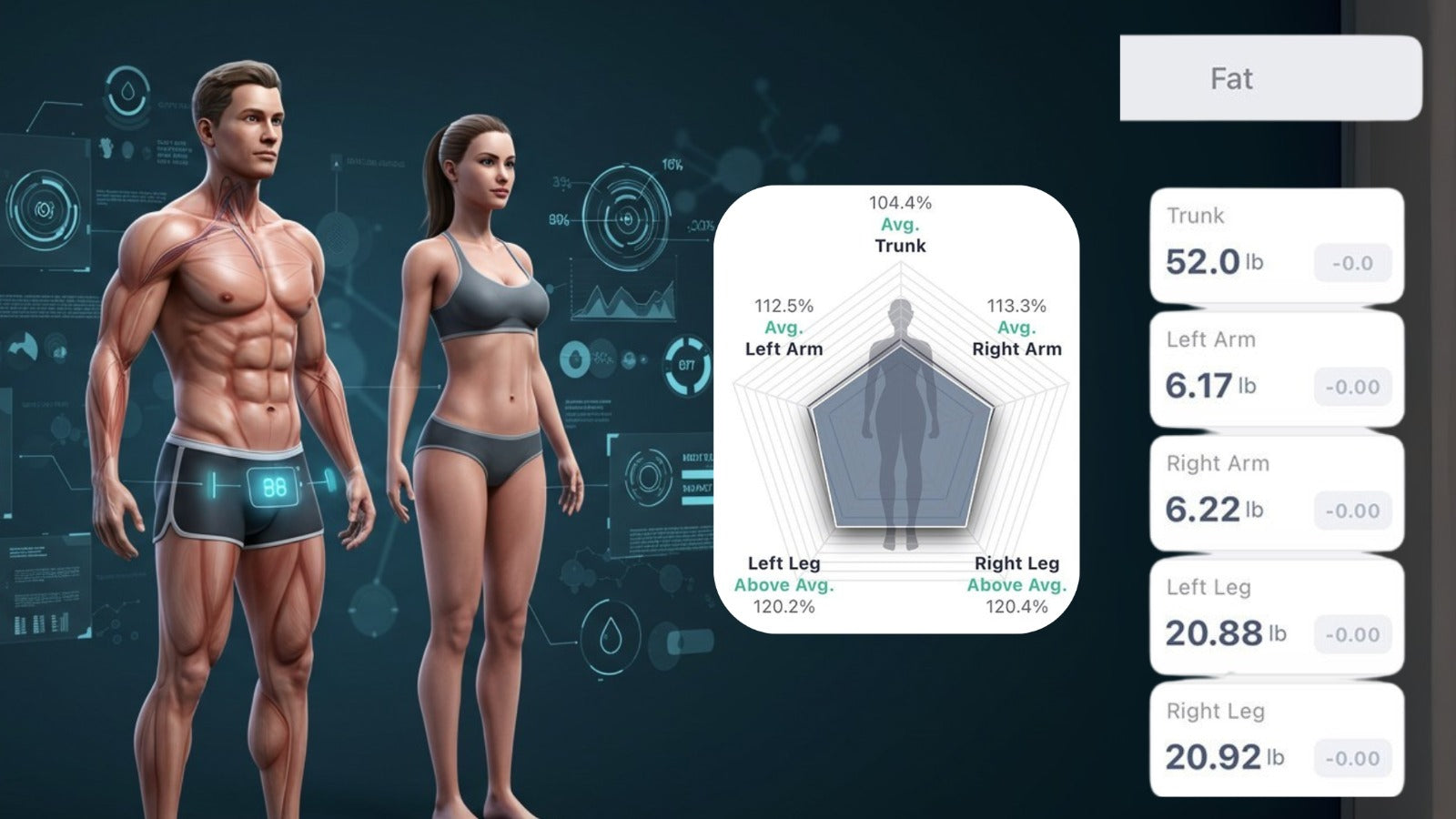When it comes to understanding our bodies, looking at the bigger picture isn’t always enough. Imagine being able to see exactly how your muscle, fat, and water are distributed—not just overall, but in each arm, leg, and even your trunk. This is where Segmental Body Analysis comes in.
Segmental Body Analysis measures the composition of each limb and the trunk separately, rather than giving just a single body-wide summary. This targeted breakdown of muscle mass, body fat, and water by segment empowers more informed health and fitness decisions. Instead of treating the body as one uniform cylinder (as simple scales do), segmental analysis reveals, for example, if one leg is weaker or fatter than the other. As we’ll see, knowing where fat and muscle lie (body fat distribution) can guide training, nutrition, and medical care in very specific ways.
Introduction: Body Composition and Empowerment
Imagine stepping on a scale and seeing more than just your total weight. Body composition analysis tells you how much of your weight is muscle, fat, and water. But even that is only part of the story.
Two people with the same body fat percentage may have very different health profiles if one carries fat primarily in their trunk while the other carries it in their legs. Segmental Body Analysis goes a step further by breaking these measurements down by body part – measuring the arms, legs, and trunk separately.
This granular insight can empower everyone from personal trainers and dietitians to doctors and fitness enthusiasts. By understanding which segments hold more muscle or fat, one can tailor exercise, nutrition, and treatment plans with precision. In today’s data-driven health world, segmental analysis turns raw numbers into actionable guidance.
What Is Segmental Body Analysis?
Segmental Body Analysis is a method that measures the composition of each major body segment (right arm, left arm, trunk, right leg, left leg) individually. Traditional whole-body scans assume the body is one cylinder or rely on empirical formulas; in contrast, segmental analysis treats each limb and the torso as separate.
Using both hand and foot electrodes, a segmental device sends electrical currents through each limb and the trunk, producing individual readings for each part. In practical terms, this means the machine tells you: “Here’s how much muscle and fat is in your right arm, left arm, trunk, etc.”
Segmental data is far more informative than a single body fat percentage:
-
Detecting Imbalances
It can highlight muscle imbalances or weaknesses in specific body parts. For example, a physical trainer can see if one leg’s muscle mass is lagging behind the other and adjust the workout to fix that imbalance.
-
Targeting Fat and Water Changes
It can reveal uneven fat distribution or fluid retention. If weight gain shows up mostly in the trunk, it might be visceral fat or edema; if it’s in one limb, it might indicate localized swelling.
-
Customizing Plans
With segmental data, interventions can be tailored. An injury might cause muscle loss in one arm; segmental readings let clinicians track that arm separately and ensure it rebuilds properly.
-
More Accurate Health Assessment
Since each segment differs in size and composition, measuring them separately avoids errors. For instance, a small change in trunk impedance (due to more muscle there) can hugely affect total measurements if not accounted for.
By breaking down body composition, segmental analysis provides a detailed map of the body’s muscle and fat, which is invaluable for targeted training, rehabilitation, and health monitoring.
How BIA Technology Works for Segmental Analysis
Segmental body analysis is usually done with BIA technology – Bioelectrical Impedance Analysis. BIA works by sending a painless, low-level electrical current through the body and measuring how much the body resists (impedance). Since lean muscle tissue contains more water and electrolytes, it conducts electricity much better than fat or bone.
In other words, muscle = high conductivity (low impedance) and fat/bone = low conductivity (high impedance) (scienceforsport.com). The device uses these readings and known ratios (e.g. water is 73% of muscle mass) to estimate how much of the body is muscle, how much is fat, and how water is distributed.
Modern segmental analyzers like InBody body composition analyzers use electrodes on both hands and feet, so the current passes through each arm, leg, and the trunk separately. Crucially, they employ multi-frequency currents. Low-frequency currents (~5–50 kHz) travel mostly through the extracellular water (ECW), while higher frequencies (1 kHz to up to 3 MHz range) can cross cell membranes and measure total body water (TBW). For example, devices use a wide range of frequencies (from 20 kHz up to 3 MHz in advanced models) to distinguish extracellular vs. intracellular water for each segment.
Key points about BIA technology:
-
Tissue Conductivity: Lean tissue (muscle) is water-rich and conductive; fat and bone resist current. The device calculates “impedance” (resistance) to estimate muscle vs. fat.
-
Segmental Electrodes: By placing electrodes on the hands and feet, the device measures five separate “impedance paths” (each limb and the trunk) simultaneously. This avoids assumptions of symmetry and gives raw segmental impedance values for arms, legs, and torso.
-
Multi-frequency Benefits: Using multiple frequencies improves accuracy. Low frequencies stay outside cells (ECW), high frequencies go through cells (TBW). Some devices use of up to 3 MHz current even penetrates cell membranes more thoroughly, enhancing intracellular water measurement.
-
Ease and Speed: BIA is quick tests that take 90 seconds, safe, and non-invasive. An 8-point electrode design (one current and one voltage electrode on each hand and foot) ensures that each test starts from the same points, improving reproducibility.
-
Limitations: Despite its convenience, BIA accuracy can be affected by hydration, recent meals, and exercise. For example, dehydration increases body resistance and can overestimate body fat. Therefore, standard testing conditions (fasted, rested) are recommended for reliable results.
Overall, BIA technology provides a scientifically grounded way to quantify body water, which translates into muscle and fat estimates. Segmental BIA devices build on this by measuring each limb and the trunk directly, yielding much more actionable data for health and fitness.
Applications in Health and Fitness
Segmental body analysis has many practical applications. By revealing detailed composition data per limb and trunk, it benefits both clinical care and athletic training:
Clinical Settings
-
Sarcopenia Monitoring: In older adults, maintaining muscle mass in the legs and arms is crucial for mobility and fall prevention. Studies show people can lose up to 50% of muscle between ages 20 and 90. Segmental analysis lets doctors track muscle decline in the legs separately, enabling interventions (e.g. leg strengthening) before falls occur.
-
Injury Rehabilitation: A patient recovering from a broken arm or knee surgery can be monitored by comparing the injured side to the healthy side. A physiotherapist can see if the injured limb’s muscle is regaining mass over time, and adjust therapy accordingly.
-
Chronic Disease Management: Conditions like lymphedema (fluid buildup) or cachexia (muscle wasting) often affect specific body parts. Segmental BIA can detect abnormal fluid retention (high ECW/TBW ratio) or localized muscle loss, guiding treatment.
-
Nutrition and Hydration Tracking: Dietitians can use segmental data to see if a patient’s weight gain is fat or water in a particular segment (e.g. edema in the legs vs. fat gain in the trunk). This precision improves nutritional advice.
Fitness and Sports
-
Balanced Development: Trainers use segmental readings to ensure an athlete is building muscle evenly. For example, if a swimmer’s left arm is less muscular than the right, workouts can target that imbalance. Detecting these asymmetries helps prevent injury and improve performance.
-
Performance Tracking: Bodybuilders and athletes can chart segmental muscle growth and fat loss. Seeing “eyes-on” data for each muscle group (arms vs. legs vs. core) validates progress beyond just scale weight.
-
Rehabilitation: Even in sports, if an athlete is sidelined with an injury, segmental BIA can quantify muscle atrophy in the affected limb and track recovery during rehabilitation.
General Fitness: Health-conscious individuals using analyzers can fine-tune their programs. For example, knowing that most fat is stored in the trunk rather than limbs (body fat distribution) may shift focus to core exercises or nutrition adjustments.
Conclusion
Segmental Body Analysis matters today because it turns generalized body composition data into personalized insight. As healthcare and fitness become more data-driven, knowing where fat and muscle reside can make all the difference. It allows practitioners to set precise goals: build muscle in a weak limb, reduce fat where it’s most dangerous, or address hydration imbalances. In short, segmental analysis empowers smarter decisions for individual needs.
Advances in BIA technology—like direct segmental multi-frequency analyzers—have made this precision accessible. They provide accuracy and reproducibility that clinicians and trainers trust. Whether it’s preventing sarcopenia in seniors, rehabbing an injury, or optimizing an athlete’s body symmetry, segmental data offers an evidence-based path forward.
In today’s context of personalized medicine and fitness, understanding your body by segment is no longer a luxury; it’s a powerful tool. Segmental Body Analysis equips you with the detailed muscle and fat breakdown needed to tailor nutrition, exercise, and treatment – ultimately leading to better health outcomes and performance.

